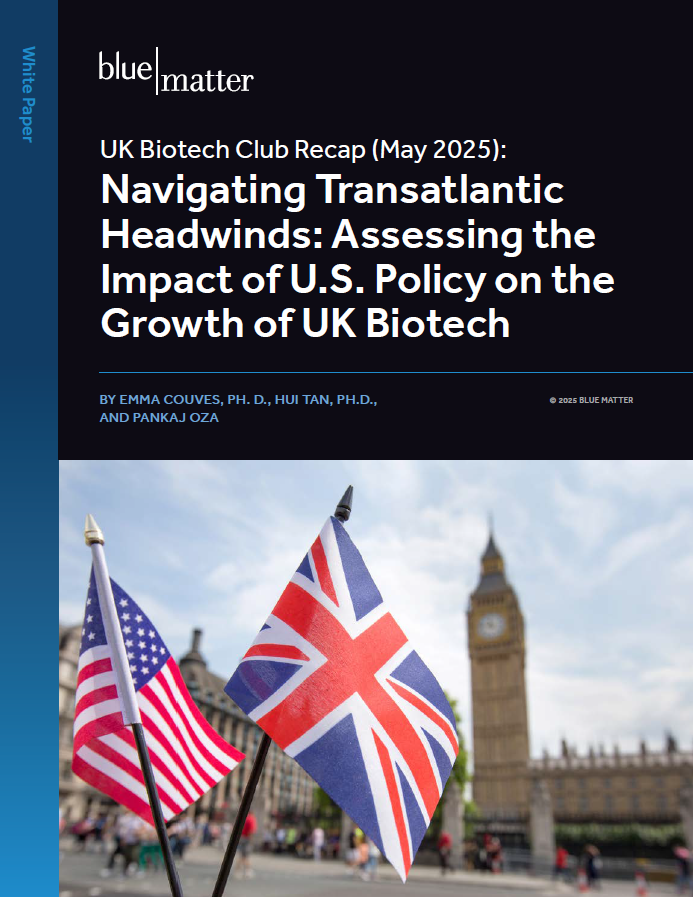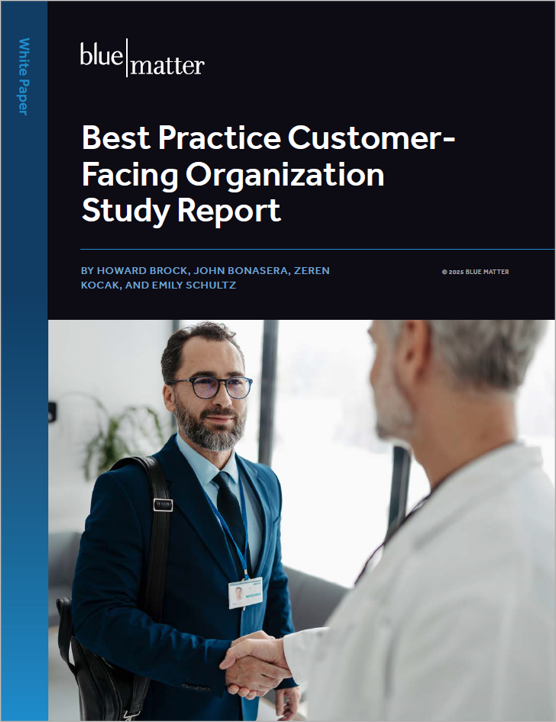
The University of Oxford is regularly ranked as the best in the world. However, it is widely accepted that the associated biotech landscape is not as advanced as comparable locations in the US. For example, Boston is well-established as an innovation hub while Oxford remains nascent. Nothing is permanent, though, and in a dynamic space like biotechnology, market evolution can happen quickly.
On October 5th, 2022, Blue Matter’s London team hosted a reception and dinner meeting attended by representatives from more than 15 biotech companies in the Oxford biotech sector. These companies included relatively new start-ups, technology platform companies, and established biotech firms. The representatives were primarily C-suite leaders who came together to discuss goals, challenges, and potential solutions across a range of topic areas.
As our team helped to facilitate these discussions, we captured key points, opinions, and the information that was shared. Later, we analysed all that information to draw out the most useful insights, lessons learned, and key conclusions that can be taken forward to unlock the future potential of innovation in the UK biotech scene.
This paper provides a brief summary of the results, organized into six main areas of interest to innovators in this space:
- Establishing a Biotech
- Academic to Commercial Transition and Attracting Talent
- Securing Investment and Funding
- Developing Research Partnerships
- Clinical Program Development
- Going Public
Establishing a Biotech
Most biotech firms begin as spinouts from academic research. However, even this initial step has previously provided a barrier across several areas: awareness of opportunities, willingness to take risks, and the retention of equity by the universities.
On the former point, participants suggested that students and academics in UK universities are typically less aware of the potential routes for their work to be spun-out. There is limited to no teaching of commercialization or entrepreneurship in STEM topics, so opportunities are missed due to a lack of awareness.
Furthermore, academic research can sometimes be hampered by a tentative, risk-averse peer review system (of grant approvals) which does not fit with the ambitious and potentially single-minded approaches needed to drive a biotech and secure funding. Considering the US vs. Europe, it was also agreed that there is a perceived attitude difference across the Atlantic; the reaction to proclaiming that you will “cure cancer” is expected to be met with a lot more positive reinforcement and support in the US than in the UK.
Regarding the equity stake in spinouts, UK universities have traditionally been considered aggressive in maintaining a high share of any spinout and consequently limiting the attractiveness to potential investors. The University of Oxford did address this in late 2021, establishing a new policy to position itself as a more attractive partner by reducing the share it holds in IP to a fixed two-level model, increasing the equity available for founders, partners, or investors. In most cases, the new policy sets the founding equity share at 80% for founder researchers and 20% for the University. The share for founder researchers can increase to 90% when a spinout is created in the absence of any support from the University.
Key Takeaways
Increasing the rate of biotech establishment must be addressed on two fronts:
First, entrepreneurship and commercialization options should be developed to be taught alongside STEM degrees to increase the awareness of what can be achieved. It would additionally be beneficial to teach “risk appetite” in universities, potentially enabling a more balanced approach to an academic evaluation of risk vs. potential reward of spinning out.
Second, UK universities must look to the US to understand how they can better position themselves as facilitators of companies, rather than unwieldy barriers. While it is likely too early to validate whether the policy shift by the University of Oxford has led to an increase in spinouts, undoubtedly it will make the spinouts more attractive to investors due to a greater share being available in negotiations.
Academic to Commercial Transition and Attracting Talent
Biotech firms (particularly those originating as university spinouts) can benefit greatly from maintaining strong relationships with their founders and their scientific expertise and perspectives. This can help keep those firms rooted in their scientific origins.
However, there is a risk that many academics often do not fully understand or acknowledge. In many cases, academic founders underestimate the knowledge and skillsets required to be a great CFO, CTO, CSO, etc. The skill set of a great academic is not typically compatible with the requirements of the C-suite (the “academic founder conundrum”). It’s important to find roles for those founding academics that properly leverage their skills and capabilities while recruiting others who are better suited to the core business roles.
Without appropriate commercial guidance, numerous biotech firms have been unable to secure funding or have lost direction in research and have failed. Some university-connected investment organizations, such as Oxford Sciences Enterprises (OSE), employ Resident Scientists who can help “zero in” on these visionary academics to identify the innovations but are also well positioned to ensure that there is appropriate commercial support to help them to build out those ideas.
Beyond the core founding team, it can also be challenging to recruit talent into UK-based biotech firms, either from academia or from previous pharma backgrounds. This is due to the perceived risks involved. In the scenario where a biotech fails, either through negative data or lack of funding, employees in the UK are concerned about potentially longer periods of unemployment compared to the US market. In the Boston, the experience suggests far greater opportunity to secure follow-on employment, with greater remuneration to mitigate the risks of working in the biotech space.
Key Takeaways
While (co-)founders may be the best at driving the original research and the ongoing development in preclinical and early clinical stages, they are not always aware of their own limitations. Therefore, an early-stage biotech should conduct regular introspective organizational “check-ups” to ensure that the right skills and knowledge are positioned in the appropriate organizational roles. (Co-)founders must either be able to recognize where they need to step back or be coached into key research and development roles while additional expertise is employed to drive overall direction.
Biotech companies further need to recognize the risks that their employees are taking in following their founders’ aspirations. UK-based employees tend to be more risk-averse and therefore appropriate reimbursement and options packages must be in play to secure their commitment through potentially leaner times.
Securing Investment and Funding
Across both the US and EU, the discussion participants agreed that venture capital (VC) is seeking innovative approaches and “blue sky thinking” with the opportunity for large pay-outs. Despite this—and an abundance of concepts—the current economic climate has made it very difficult to raise capital, with significant time investment required to secure funding and keep VCs updated. This has particularly been felt in Europe, with many biotech companies looking “across the pond” to the US as the primary source of investors.
Specifically, in Oxford, the funding ecosystem has a few challenges (primarily driven by lower VC volume in terms of both the number of firms and dollar value) compared other market-leading locations. It was mentioned that the lack of an anchor in “Big Pharma” can further limit the availability of capital. However, this is potentially changing (e.g., Novo Nordisk, BMS, and Bayer Research Alliances).
This approach of targeting non-EU investors is widespread across biotech firms, but it’s particularly prevalent for the more innovative technologies such as cell and gene therapies. US investors are perceived to be more well-versed, with team members who will ask the right questions to assess the value of a technology and then providing the excess capital to make it happen.
Conversely, there is a perception that UK investors can be very detailed (and even pedantic in some cases) when it comes to understanding how their money will be spent. The perception also exists that UK investors tend to seek proof from the outset that the technology will succeed, then provide limited capital to do part of what’s needed. For the more risk-averse investors, a biotech securing a notable lead investor can ensure that previously hesitant parties become reliable follower investors.
However, US investors often have non-traditional expectations tied to investments. These can include establishing a presence in (or even the CEO relocating to) the US and weekly meetings with the VC to update on progress.
As a final note, the ability to raise funds was perceived to be strongly correlated with what approach or indication is “in vogue” at any given time. This can drive dramatic shifts in VC favour.
Key Takeaways
It is often hard to prove how “worthy” a technology is if it’s completely new or innovative and there is no scientific precedent. But for a biotech firm, marketing its capabilities and the value proposition of a technology are very important to getting attention and communicating asset potential to investors. There is an immediate need to develop a compelling commercial story that goes beyond the pure science.
European biotech firms should consider US-based VC, even if principally to secure a lead investor who then can be used to convert hesitant support from European investors. Similarly, Europe-based investors should reconsider their approaches and adopt successful practices from their US counterparts, increasing investment in the potentially riskier, but likely more revolutionary and commercially successful technologies.
For specific less matured biotech hubs, the teaching of commercialization, entrepreneurship, and communications will enable better positioning of assets for funding. Expanding mentorships, internships, and Ph.D. / post-doctoral funding will grow the connections between academic groups and the biotech landscape. Finally, increased collaboration between biotech firms will help promote more expansive investment.
Developing Research Partnerships
Two main research partnerships can exist; with academic groups, unlocking novel innovation and concepts, and with another company, enabling shared technologies and synergies in development.
The central objective behind forming a partnership, regardless of the partner (academic organization, pharmaceutical company, or another biotech firm), is to gain access to complementary capabilities. The goal is to work together to achieve something that isn’t possible alone. If the mindset for each partner is to achieve things that are not possible for either entity individually, then the fear of losing full control of intellectual property (IP) or commercial success goes away, as that success wouldn’t happen otherwise.
From the biotech company perspective, there are great benefits to partnering with academia as it provides access to innovation and an additional pathway to recruit talent. However, when seeking academic partners, biotech firms need to become adept at identifying the true innovators who are exceptionally clear communicators, as they are more likely to have—and be able to share—compelling visions of what can be. Establishing mentorship programs may also be a growth opportunity and a way to access new ideas as well as bridging the academic-commercial divide.
Partnering with companies typically differs from partnering with academics, as companies tend to have a greater appreciation of IP issues and concerns. While not always the case, companies also tend to be better “team players,” with an openness to others’ skills and intelligence. Academics tend to adopt a more competitive mindset with biotech partners.
Key Takeaways
There are several key points to keep in mind regarding the success or failure of a partnership:
- Many companies/ventures/partnerships/projects fail. By finding a partner with the appropriate deep expertise, and complementary to your own, this risk is reduced.
- It’s important to keep an open mind to any type of commercial partnership rather than remaining focused on a fixed model (joint venture, licensing, etc.). The best option will be dependent on your objectives and capabilities, as well as the partner’s objectives and capabilities.
- An organization can spread itself too thin, trying to do everything on its own. That is a greater risk than building a partnership. Sharing capabilities to address agreed-upon needs or questions could be an approach to improve attractiveness to investors.
- “Validating partnerships” with pharma companies had gone out of vogue but may be returning due to the current challenging financial environment.
- Finding the right collaboration is key. There must be clear objectives and desired outcomes with defined milestones (for the academic this may be X number of papers, for the company it could be a number of targets identified, access to talent, a number of assets generated).
- Positioning as a “platform company”, with multiple partnerships, is risky. For example, a company that can tell you the right target for a drug may be worth $1 billion. A company that can build a clinical pipeline for development might be worth $100 billion, but escaping the view that a company is “just a service company” takes a lot of hard work.
Finally, when seeking potential partners, some companies struggle to bring in interest despite “knocking on many doors” whereas others have people “beating down their doors.” Proper positioning and illustrating your own expertise are keys to being an attractive partner. It means having a “hot” topic or approach and being able to sell it effectively.
Clinical Program Development
When developing clinical research programs, biotech firms do not typically have the luxury to spend expansively, absorb multiple failures, or to field poorly design programs. From the outset, they must make well-informed and strategic decisions to prioritize their lead indication(s), considering factors such as the level of unmet need, existing translational pathways, and competitive intensity. They must also consider the feasibility of demonstrating the proof-of-concept (POC) early through shorter duration trials, biomarkers / surrogate endpoints, or indications more amenable for trial recruitment. Other potential data needs can include establishing a robust natural history of the disease to validate the unmet need and provide an indirect comparison for open-label or single-arm trials, especially for the most innovative technologies (e.g., cell & gene therapies).
The ability to validate hypotheses early will help keep existing funders invested and attract greater interest in future funding rounds.
Key Takeaway
While not always the greatest commercial opportunity, targeting the most straightforward indication with a clear value proposition—or that with the easiest path to POC—is often the most valuable in the short-term to validate the technology.
Going Public
It is typically considered easier for companies to go public in the US and to get a larger valuation, which leads to a channel of UK-based biotechs turning to the US for their initial public offerings (IPOs). Also, the NASDAQ is well-entrenched in the life sciences, with a notable difference in the quality of analysts in both technical and scientific knowledge vs. the London Stock Exchange (LSE). Furthermore, there is the perception that in the US market, stock is generally held for longer periods and share value is more likely to grow.
One risk with going public is that public companies have more restrictions on how they can spend the money they raise. Pre-IPO biotech firms have more flexibility to pivot approaches post-funding, whereas public companies are more tied to the original aims of the additional funding.
Key Takeaway
Currently, the NASDAQ is considered the only place for a biotech IPO, with AIM or LSE the last place, after other European or even Asian markets. For this to change, the UK market must incentivise biotech firms to make their IPOs on AIM / LSE and demonstrate a series of success stories to reposition the AIM / LSE as preferred for home-grown biotechnology firms.
Parting Thoughts
As described above, the participants in our discussion outlined a range of challenges present in the Oxford / UK biotech ecosystem. It often lacks the venture capital muscle that’s found in places like Boston, the local stock exchange is not ideal for IPOs, and it can be challenging to recruit talent for an expanding company. In addition, the Oxford area currently has no “Big Pharma” anchor and developing an environment conducive to that on a large scale will require investment and additional infrastructure.
However, these challenges have been recognized and the landscape is already evolving. The biotech field is a dynamic one. With increased collaboration between universities, biotech firms, and other stakeholders, these issues and commercialization hurdles can be overcome. Better education programs within academic settings can accelerate the growth of spinouts and promotion of the Oxford sphere to attract expansive investment can create a more appealing biotech environment. We look forward to the future and will work to help make it happen.






